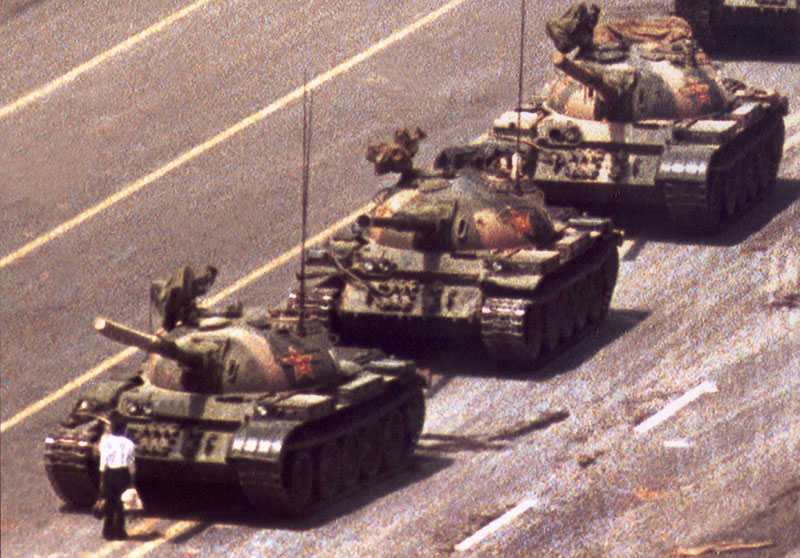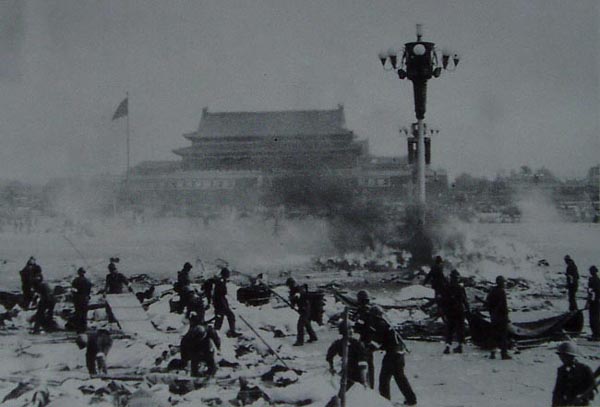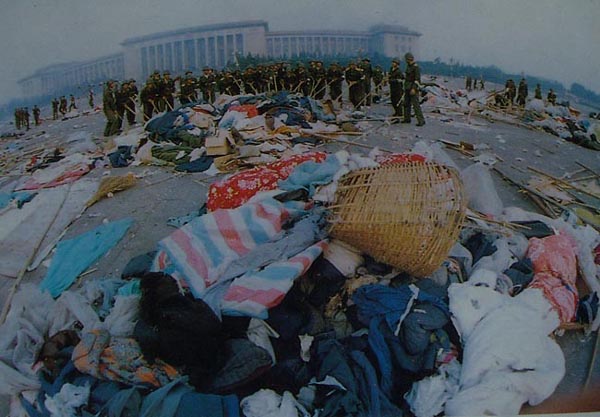There are so many obstacles and versions about the Tiananmen Square Incident, mostly coming from the Chinese government that we feel behooved to ask,
"Is it at all possible to ever know the truth about the Tiananmen Square Incident (massacre)?"
Presently the truth has been made inaccessible and hazy, and it is far less likely that
the reality will come to light until there is a real democratic system in
China.
The Tiananmen Square Incident what started as a pro-democracy movement in
1989, after nearly two months deadlock, it eventually ended up being a tragedy in which a number of people needlessly died.
To a certain extent, the government's immediate reaction was aimed to distort the fact.
To a certain extent, the government's immediate reaction was aimed to distort the fact.
"The state did give its own version of events immediately after the violence in 1989. Chinese television showed ragged protesters with black arm bands throwing Molotov cocktails and army vehicles set on fire." (Beam C 2009).
This shows that the Chinese government wants to
make people to believe that there was a rebellion.
(similar to how they handled the ramifications of
23rd July, 2011 train crash by enacting a virtual media blackout on the
disaster except for positive stories)
They not only wanted to fabricate an alternate set of truth for Chinese people, they
also tried to block the flow of information.
"...Some foreign journalists were subjected to an inquiry, their electronic equipment was also examined by the CPLA..." (Forney M 2001).
The COMMUNIST PARTY'S immediate reaction to this event show that their aim is to prevent the truth to come to light which also justified them to have further repression and censorship on ordinary Chinese people.
For example, they confiscated the freedom of rights to those people who want to tell the truth. "(and still continue to do so with self-righteous gusto). Free expression activist Liu Xiaobo, one of the leading figures of the 1989 movement, was recently re-arrested.
Several journalists, including Shi Tao, who was sentenced to 10 years in prison for sending an email about the Tiananmen Square anniversary in 2004, are still in prison for referring to the massacre." (RSF 2009). This, without a doubt, proves that the government less interested in allowing the spread of the facts from the inside.
In short, They don't want to disclose the facts.
Now, we all know (right? don't we?) that China's communist rulers (dictators) have distorted and denied
the truth about what happened 20 years ago in Tiananmen Square. But they
aren't the only ones. In an equally disturbing betrayal of history,
Western human rights activists and liberal commentators have also twisted
the sad story of the events of that fatal day, creating a fairytale version of events that
bears little relation to what happened in those bloody days of June
1989.
Twenty years on, the Communist Party of China (CPC) still continues to play
down or deny the seriousness of the protests and massacre. It
insultingly refers to the events as the "4 June Incident" (as though something trivial or nothing had happened). It claims
that "only" 241 people died, including soldiers, much to their dismay, some other reports (who?) put the number of deaths in between 1,500 and 3000.
Chinese Communist Party denies its citizens access to information about the events: search for "Tiananmen Square massacre" on the internet in China and you'll be told: "This page cannot be found." The truth telling pages are being put down or censored.
 |
| Tiananmen Square, and the area of Chang'an Boulevard in front of it, became an army camp after more than 100 tanks came into the city overnight. |
 |
| Ten armed soldiers beating a protester to death in during the massacre |
Chinese Communist Party denies its citizens access to information about the events: search for "Tiananmen Square massacre" on the internet in China and you'll be told: "This page cannot be found." The truth telling pages are being put down or censored.
Western human rights groups have not indulged in such denialism, but
they have employed much mythmaking of their own, airbrushing from
history what they consider to be inconvenient facts and creating a neat
but terribly skewed morality tale about June 1989.
The main victims were workers in Beijing suburbs - now forgotten by the West Thanks
to the images propagated by groups like Amnesty and Human Rights Watch,
most Westerners think the Tiananmen Square Massacre involved Chinese
soldiers shooting pro-democracy students in the central square of
Beijing.
The most famous image from the protests - that of a student standing in front of tanks - strengthens the idea that was a simple Students vs Soldiers story. This is unforgivably inaccurate.
 |
| Famous "students vs tanks" Image |
The most famous image from the protests - that of a student standing in front of tanks - strengthens the idea that was a simple Students vs Soldiers story. This is unforgivably inaccurate.
It is of course true that in May and June 1989 many students set up
camp in Tiananmen, where they demanded democratic and economic reforms,
and that some of them suffered when the CPC launched its military
clampdown on 3 and 4 June. Yet there were uprisings across Beijing, and
in other parts of China, and the main victims of the unspeakable violence -
now largely forgotten thanks to Western human rights activism - were not
students in the square, but ordinary workers miles away in the suburbs
of Beijing.
The Chinese authorities sent their tanks to crush a workers' rebellion. In their fascinating book Black Hands of Beijing: Lives of Defiance in China's Democracy Movement,
human rights experts George Black and Robin Munro wrote:
"What took place was the slaughter not of students but of ordinary workers and residents - precisely the target that the Chinese government had intended."
Black and Munro point out that the workers of Beijing, whose lives
had become harsher as a result of Premier Deng Xiaoping's introduction
of crude market reforms from the late 1970s onwards, had "much more to
be angry about than the students", and the CPC's aim was to "crush
them".
The fact of the matter is that the worst state violence occurred miles away from Tiananmen Square in
the western suburbs of Beijing, where, as China expert Jonathan Fenby
puts it, there was a "far bigger massacre of non-students". Hundreds of
workers were gunned down in the streets, which is why some people,
including many Chinese dissidents, refer to the events as "the Beijing
massacre" rather than the "Tiananmen Square massacre".
Indeed, just as the CPC's use of the term "4 June Incident" for referring to that incident and the derogatory term "ruffians" or "rioter" for referring to the victims, gives the
impression that this was a minor event, so the Western-created name of
"Tiananmen Square massacre" depicts a serious city-wide uprising as a
small-scale, one-square clash.
Jay Mathews, former Beijing correspondent for the Washington Post,
says Western journalists have spread irresponsible stories about a
square-based massacre:
"Hundreds of people, most of them workers and passers-by, did die that night", he says, "but in a different place [to the square] and under different circumstances".
Yet if you question Western representations of June 1989, says
Mathews, you'll be looked upon as a pedant or worse, a Tiananmen denier. Tell
journalists they have given misleading accounts and they will say:
"So what? The Chinese army killed many innocent people that night. Who cares exactly where the atrocities took place?"
In China, debate about June 1989 is curtailed by censorship - in the
West it is discouraged by those who have propagated the simplistic
Square story.
Perhaps feeling they have more in common with the students in the
square - who, unlike many of the rioting workers, were peaceful and
erudite - Western observers have made the students the central focus of
the June 1989 story. Whether wittingly or unwittingly, they have pushed
from public view the key victims of the Beijing Massacre.
They have also, in a terrible irony, done the Chinese authorities a favor, helping to represent what was a state-shaking uprising by
thousands of workers, residents and students in Beijing and beyond as a
relatively small, polite, Amnesty-style protest for "reform".
Read more: Here





No comments:
Post a Comment
DO NOT USE INVECTIVES! Keep it civil, please!